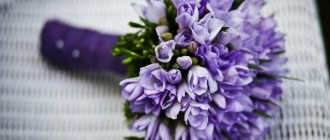Shades of purple in landscape design
Purple is considered a “cool” color and includes many shades. Some of them have their own name associated with a natural standard, for example, light purple is lilac, violet is deep purple, lilac is pale shades of dark purple, bright and rich purple is lavender. Magenta (magenta) is sometimes considered a shade of violet, although it is made by mixing red and violet (blue).
When choosing a place for such flowers, you need to take into account that in the bright sun the color gradually fades and fades, so it is good if the area is a little shaded at midday. In the shade you won’t have to count on bright colors, but the “neighbors” will save the situation - plants with light or silver leaves, decorative filling in light colors.
Recommendations for using purple flowers:
- cool colors look great both in monochrome combinations and in contrasting ones when white, yellow, cream, apricot colors are added;
- creating a bright accent against a background of light colors;
- a variety of shades gives volume to the space, visually distances the object (for example, a path decorated with lavender or catnip seems longer);
- a composition with white, cream, silver flowers will give the flower garden lightness and airiness;
- Based on purple perennials, you can create compositions in different colors every year.
Related article:
Cuttings of roses - a simple way of vegetative propagation
Mattiola
Night violet or matthiola is currently lost among modern fashionable flowers. Many gardeners avoid planting it in their flower beds - its flowers are small, inconspicuous, although they look like a small cloud.
During the daytime, the flowers are almost closed and look withered, which does not decorate the garden. But in the evening the inflorescences come to life: white, purple, yellow inflorescences emit an intoxicating aroma. In the morning the flower looks like “Cinderella” again.
Mattiola blooms all summer, from June to the last days of August. Levkoy also belongs to the genus Matthiola; this species has more beautiful flowers, but is inferior in aroma to annual Matthiola.
Lilac and purple perennials for the garden
Garden flowers of noble purple shades have a magical appeal - they combine the calmness of blue and the energy of red. Among them there are annuals and perennials, so there are many options for use in landscape design.
Ageratum Houston (Houston) or Longflower (Ageratum Houstonianum)
The herbaceous perennial is characterized by long and abundant flowering - the flowering period lasts from the beginning of June until frost. Hence the second name - “long-flowered”. Goes well with any annuals and low-growing perennials.
Upright stems, depending on the variety, reach 15-50 cm in height. The wrinkled, bright green leaf is jagged and triangular in shape. Small tubular fragrant flowers are collected in small (1 cm) baskets, which form a fluffy inflorescence-scutellum about 10 cm in diameter. “Fluffiness” is imparted by elongated stigmas that match the color of the flowers. Seed ripening begins in August-September.
Varieties with lilac flowers: Blaue Kappe, Blie Mink, Fire Pink (dark pink flowers, lilac buds).
Astra perennial
Perennial asters occupy a leading position among flowering plants. Elegant, varied in color, ideally combined with other crops, frost-resistant, unpretentious - that's all about them. You can choose varieties with different flowering periods, and the flower garden will be bright and decorative from spring to late autumn.
Alpine asters bloom in the spring, daisy asters in the summer, and in the fall comes the turn of the New Belgian, New England, and shrub ones. Dahlias, ornamental grasses and cereals, echinacea, and sedum will make excellent company for them.
Related article:
Varieties of geranium and pelargonium
Varieties of different shades of purple:
- A. alpine – Blue Star, Violetta, Illyria, Goliath, Sabine, Superbus
- A. Italian – Coerulea, King George, Kobold;
- A. sedum-leaved – Nanus;
- A. bush – Blue Laguna, Duncle Schone, Dwarf Nancy, Lazurit;
- A. novobelgian - Bengale, Royal Velvet, Purple Dom, Sara Ballard, Marie Ballard, Sunset;
- A. New England - Bars Pink, Browmann, Constance, Doctor Eckener, Glorie de Kronstadt, Purple Dome.
Delphinium
Garden forms of perennial delphinium are, most often, hybrids, with a height of 80 to 200 cm. The stem is rigid, straight, and does not branch. The serrated, beautiful, feathery leaves form a rosette. All the beauty of the delphinium is in the long, sometimes reaching 1 m, apical inflorescence, consisting of large (4-6 cm) flowers. Flowering lasts from June to July. They look impressive in groups of the same color, in compositions with flowers of warm shades.
Hybrid varieties: lilac Сameliard, terry purple Sweet Sensation, dark purple Black Night, King Arthur, Ajax, King Arthur, Black Knight.
Oregano or oregano (Origanum vulgare)
Unpretentious oregano, planted in monochrome groups or in composition with deciduous plants, looks gentle and charming, despite its “simplicity”. The erect stem is slightly pubescent, strongly branches in the upper part, and grows from 50 to 70 cm in height. The oblong leaf (1-4 cm) is pointed at the tip, has slight pubescence, and is darker at the top than at the bottom. Small flowers form a corymbose-paniculate inflorescence. Does not grow well in acidic and clay soils. Reaches maximum decorative effect in well-lit areas.
Related article:
Types and varieties of phlox
Decorative varieties:
- Rainbow - has medicinal properties, the height of the bush is 60-70 cm, the flowers are very fragrant, the buds are rich purple, the leaves are bright purple;
- Beauty Kent – drooping stems, flowers collected in a small brush, the inflorescence contains lilac and white shades;
- Herrenhausen is a variety of German selection, purple inflorescences, blooms in the second half of summer.
Clematis
Luxurious clematis will decorate any area - space, and not much of it is required, can always be found for vines. Clematis bloom profusely and for a long time, surprising with the variety of shapes and colors of inflorescences, leaves, and flowers. Depending on the variety, the length of the stems reaches 90-250 cm.
Varieties:
- Arabella is a winter-hardy variety with large blue-violet flowers, about 2 m high, blooms from June to September;
- Ashva - suitable for the climate of the middle zone, the flowers are large, flat, purple-violet, height - up to 2 m;
- Astra Nova - petals are purple along the edge, white in the center, does not tolerate frost without shelter, stems grow up to 2.5 m;
- Ball of Flowers - the variety is not frost-resistant, the petals of a delicate lilac color are wide at the base, blooms in June-July and August-September;
- Baltyk - a variety with purple flowers, most decorative in openwork partial shade;
- Copernicus – winter-hardy, shoots no more than 2 m long, double flowers, purple, blooms from June to September;
- Daniel Deronda - a variety for warm climates, flowers with blue-violet petals, double or semi-double, stem length - up to 2 m;
- Jackmanii is winter-hardy, the stems reach a length of 4 m, the flowers are purple, the flowering period is from July to October;
- Gabriel Narutowicz – lilac-violet variety, poor frost resistance, height – up to 2 m;
- Gisela – shoots no higher than 1.5 m, purple petals and lilac stamens, frost-resistant;
- Gipsy Queen - purple sepals, blooms profusely from July to October, stem length - 3-4 m.
Interesting! Varieties of clematis
Liatris spicata
The herbaceous corm perennial is valued for its high decorative properties and long flowering (1-1.5 months). Suitable for group plantings, zoning, designing paths, creating contrasting, calm color spots.
Related article:
Toadflax for your garden: types and description
The height depends on the variety. The stem is bare or slightly pubescent, the leaf is narrow and long. At the end of the flowering shoot there is a spike-shaped cylindrical inflorescence (about 35 cm long), collected from baskets consisting of small fluffy bell-shaped tubular flowers. Flowers begin to bloom from the top of the inflorescence, which gives the plant originality and originality.
Varieties: Floristan with a varied range, dark purple Floristan Violett, purple-pink Kobold, lilac Flamingo.
Monarda or garden bergamot
Tall herbaceous plants, including monarda, perfectly complement ornamental shrubs, so they are used in landscape design to create various color compositions. The stem of monarda is erect, branched, the leaf is oblong, ovate, with a pleasant aroma. From June to September, small tubular flowers bloom, collected in capitate inflorescences. Leaves and flowers, fresh and dried, are used to flavor tea drinks.
Varieties: violet-lavender Elsie's Lavender, dark violet, pink, raspberry Panorama, violet Lambada, violet Blaustrumpi, Pawnee, Sinta-Sinta, pink-violet Lemon aroma.
Rose
The cool shades of roses are not entirely familiar, but thanks to breeding work, varieties with lilac and purple flowers have been bred for the garden.
Among them are climbing, border, bush, ground cover, standard roses:
- lilac varieties - Avant Garde, Indigoletta, Lilac Rain, Lilac Fog, Blue Moon, Ocean Song, Twice in a Blue Moon;
- shades of purple – Ebb Tide, Lavander Ice, Dalilah, Mainzer Fastnacht.
Clematis hedge
Plants with climbing purple flowers are clematis. They can have a dark blue, lilac or light blue tint. Stems climbing along hedges or the wall of a house, which are strewn with hundreds of large flowers, create an unusual atmosphere in the garden. Clematis decorate gazebos, pergolas or arches. These flowers can be called the queen of vines. They belong to the buttercup family and are distributed throughout the world. Clematis can adapt to any climatic conditions, therefore they are resistant to both severe frosts and heat.
The length of clematis stems can reach 5 m. Despite the small thickness of the stem, it is very strong. Leaves can have different shapes, shades and density. Clematis flowers can be simple, semi-double or double.
Planting and care
Clematis should be planted in a sunny place, protected from strong winds. Acidic soils and stagnant water are detrimental to these plants. Clematis grow rapidly, so they require a lot of nutrients. Since this flower is a perennial, it grows in one place for up to 10 years.
In the planting hole you need to add rotted humus, mineral fertilizer, slaked lime and wood ash. Clematis can be planted in spring, at the end of April, or in autumn, in September-October. It is better to use rooted two-year-old cuttings as planting material. After planting, the roots need to be spread over the surface, covered with soil and watered. The root collar should be buried 10 cm into the ground to protect the roots from frost and overheating.
It is necessary to prepare support for stems and shoots. A lightweight, elegant and stable design will do. Intensive growth of shoots will begin in the spring (12 cm per day), so you will need to guide them along the support.
This plant with purple flowers is unpretentious in care ; it requires: weeding, loosening and watering. In the spring it is necessary to add urea, and in the summer during flowering it is necessary to feed it with a complete mineral fertilizer with microelements.
To prepare clematis for wintering, the ground near the flower needs to be weeded, loosened and the shoots cut off, leaving 2 nodes. After this, it is necessary to cover it with 12 cm of soil so that the plant does not freeze. In spring, clematis are unplanted. To propagate clematis, bush division, cuttings and seeds are used.
purple flowers
The purple color is represented by a range from burgundy, dark red to violet colors and their shades. If it is dark purple, then it is violet and burgundy; if it is light, it is lilac, mauve. Dark shades narrow the space, while light shades blur the boundaries of the flower garden and give it a romantic mood.
Related article:
4 types of Fothergilla: description and care tips
For purple flower beds, the ideal combination is different shades of purple, diluted with other colors. A place for them should be chosen in a sunny or slightly shaded area - purple looks gloomy in the shade.
Foxglove (Digitalis purpurea)
The height of the erect stems, covered with glandular hairs, reaches 1.2-2 m. Petiolate leaves (up to 30 cm) form a basal rosette, the stem leaf is sessile. A lush inflorescence is collected from large bell-shaped flowers. Varieties with purple flowers: Excelsior, Muse, Fooksi, Candy Mountainein.
Purple sedum (Sedum telephium)
The stems are erect, single or form a low compact bush with a height of 15 to 65 cm. The height depends on the variety and growing conditions. The leaf is fleshy and comes in various shades of green. Small flowers are collected in a loose inflorescence with a diameter of 3-8 cm. Flowering begins in July and lasts about 2 months. Purple sedum is an excellent honey plant that attracts pollinating insects.
Varieties: Black Jack, Bon Bon, Picolette, Postmans Pride, Xenox.
Sweet pea
It can transform any piece of the garden; you just need to take care of high supports on which the shoots can cling in their quest to rise higher towards the sun. After all, sweet peas can climb to a height of two meters, decorating gazebos and covering fences with their greenery.
The annual liana has many advantages: it is unpretentious, has a high potential for rapid growth, a long flowering period, original flowers of a wide variety of shades and an amazing aroma that intensifies at night.
Fragrant tobacco
After the beginning of flowering, the gramophones of fragrant tobacco are open during the daytime, but they are most fragrant at night. It has been cultivated since the end of the eighteenth century, during which time breeders have developed many varieties with flowers of different colors; plant heights can range from 20 to 90 cm.
Flowering is long, and at the beginning of autumn, fragrant tobacco will delight flower growers with its fragrant flowers.
Mirabilis
The rather attractive “Mexican” mirabilis will enliven your garden with its bright flowers of various colors: crimson, orange, purple, white, violet, yellow, red. She will also surprise you with flowers of the same color, but different shades on the same bush.
The flowers open in the late afternoon and close at dawn. In cloudy weather, flowers can be open all day. But mirabilis only smells fragrant at night, filling the air with a sweet aroma.











